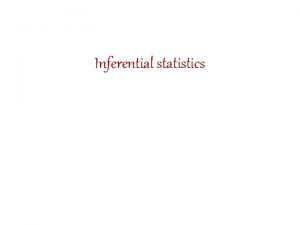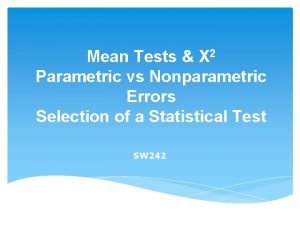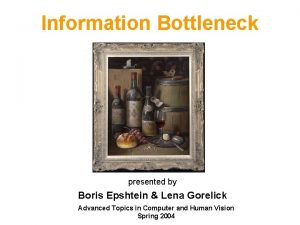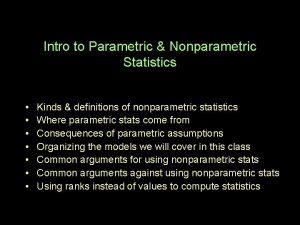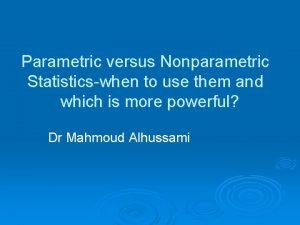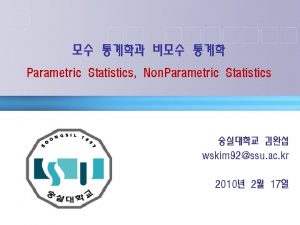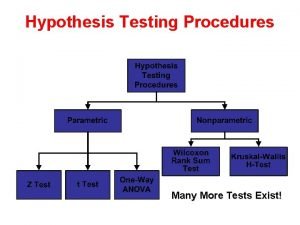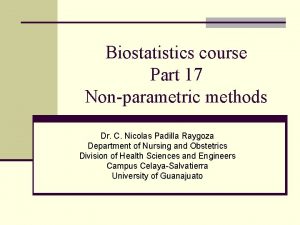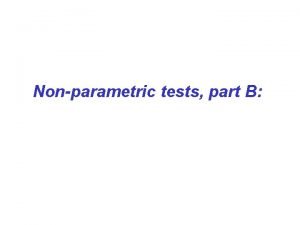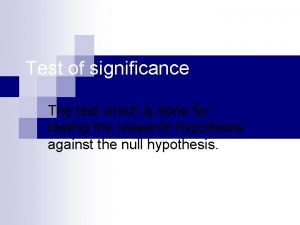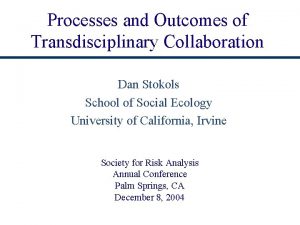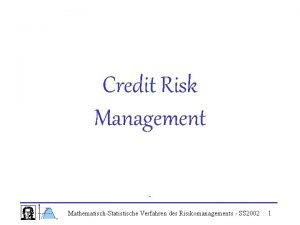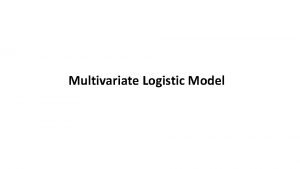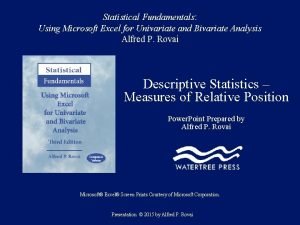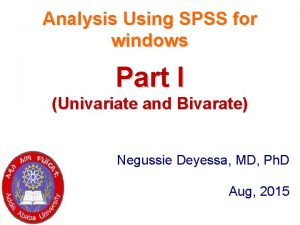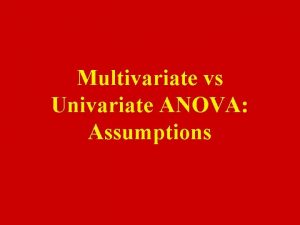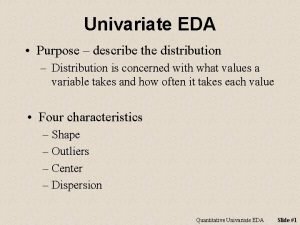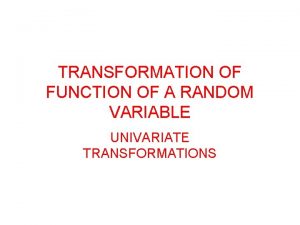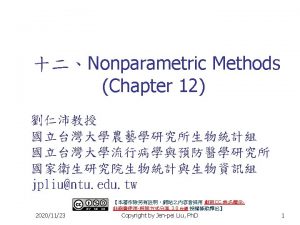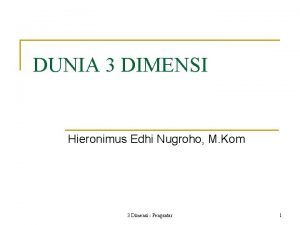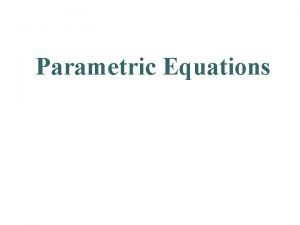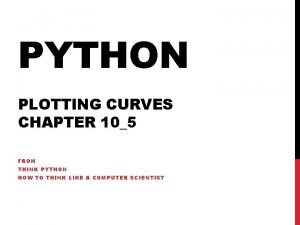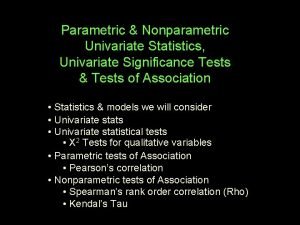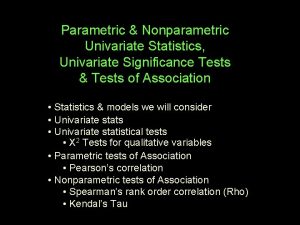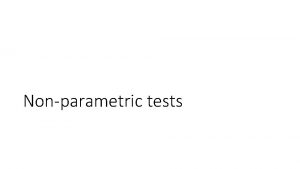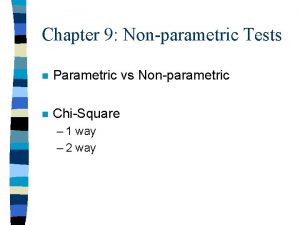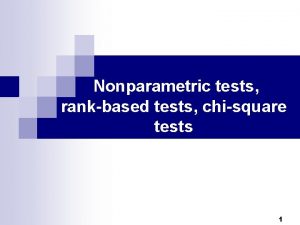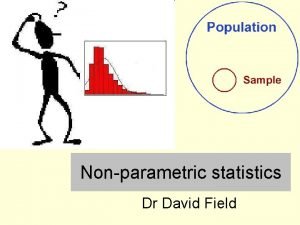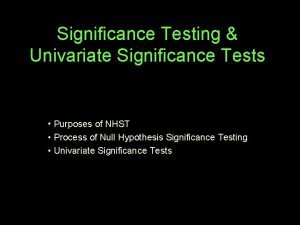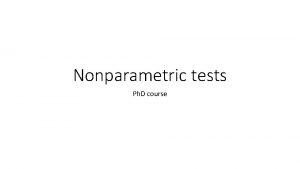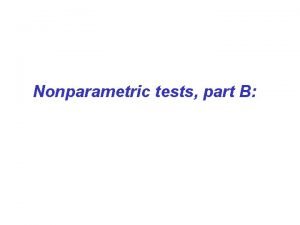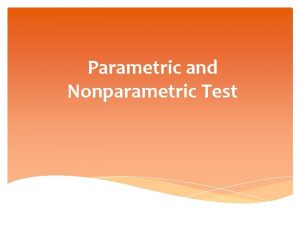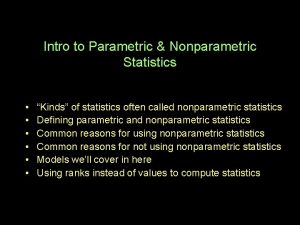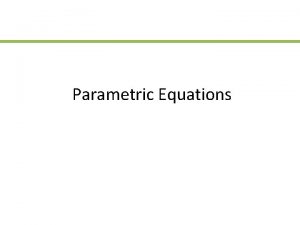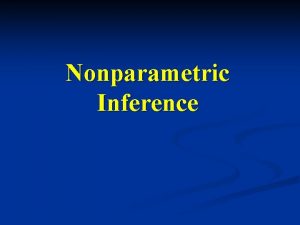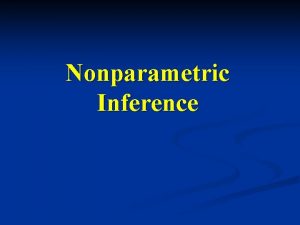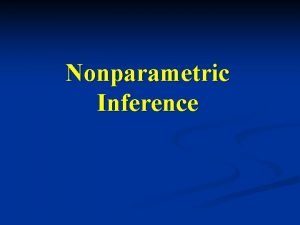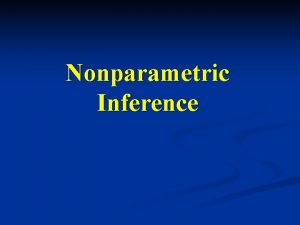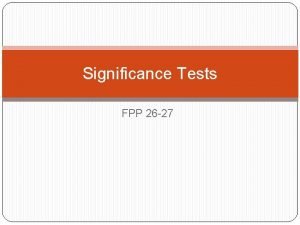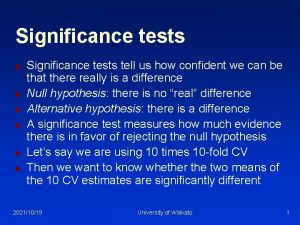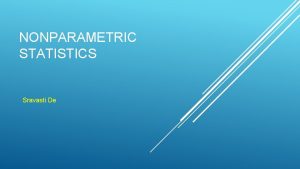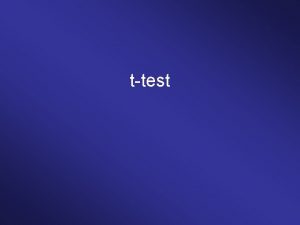Parametric Nonparametric Univariate Statistics Univariate Significance Tests Tests




























- Slides: 28

Parametric & Nonparametric Univariate Statistics, Univariate Significance Tests & Tests of Association • Statistics & models we will consider • Univariate stats • Univariate statistical tests • X 2 Tests for qualitative variables • Parametric tests of Association • Pearson’s correlation • Nonparametric tests of Association • Spearman’s rank order correlation (Rho) • Kendal’s Tau

Statistics We Will Consider DV Categorical univariate stats mode, #cats univariate tests gof X 2 Parametric Nonparametric Interval/ND Ordinal/~ND mean, std median, IQR 1 -grp t-test 1 -grp Mdn test association X 2 Pearson’s r Spearman’s r 2 bg X 2 t- / F-test M-W K-W Mdn k bg X 2 F-test 2 wg Mc. Nem Crn’s kwg Crn’s M-W -- Mann-Whitney U-Test K-W -- Kruskal-Wallis Test Mdn -- Median Test t- / F-test Wil’s -- Wilcoxin’s Test Mc. Nem -- Mc. Nemar’s X 2 K-W Mdn Wil’s Fried’s -- Friedman’s F-test Crn’s – Cochran’s Test

Univariate Statistics for qualitative variables Central Tendency – “best guess of next case’s value” • Mode -- the most common score(s) • uni-, bi, multi-modal distributions are all possible Variability – “index of accuracy of next guess” • # categories • guessing whether or not the next person has a pet is more likely to be correct than guessing the kind of pet they have (including none) Shape – symmetry & proportional distribution • doesn’t make sense for qualitative variables • no prescribed value order

Parametric Univariate Statistics for ND/Int variables Central Tendency – “best guess of next case’s value” • mean or arithmetic average M = ΣX / N • 1 st moment of the normal distribution formula • since ND unimodal & symetrical mode = mean = mdn Variability – “index of accuracy of next guess” • sum of squares SS = Σ(X – M)2 • variance s 2 = SS / (N-1) • standard deviation s = √s 2 • std preferred because is on same scale as the mean • 2 nd moment of the normal distribution formula • average extent of deviation of each score from the mean

Parametric Univariate Statistics for ND/Int variables, cont. Shape – “index of symmetry” 3 Σ (X M) • skewness (N – 1) * s 3 • 3 rd moment of the normal distribution formula • 0 = symmetrical, + = right-tailed, - = left-tailed • can’t be skewed & ND Shape –“index of proportional distribution” • kurtosis M = ΣX / N Σ (X - M)4 (N – 1) * s 4 -3 • 4 th moment of the normal distribution formula • 0 = prop dist as ND, + = leptokurtic, - = platakurtic The four “moments” are all independent – all combos possible • mean & std “are correct” as indices of central tendency & spread if skewness = 0 and kurtosic = 0

Nonparametric Univariate Statistics for ~ND/~Int variables Central Tendency – “best guess of next case’s value” • median middle-most value, 50 th percentile, 2 nd quartile How to calculate the Mdn 1. Order data values 2. Assign depth to each value, starting at each end 11 13 16 18 18 21 22 1 2 3 4 3 2 1 3. Calculate median depth Dmdn = (N+1) / 2 4. Median = value at Dmdn (or average of 2 values @ Dmdn, if odd number of values) (7 + 1) / 2 = 4 18

Nonparametric Univariate Statistics for ~ND/~Int variables Variability – “index of accuracy of next guess” • Inter-quartile range (IQR) range of middle 50%, 3 rd-1 st quartile How to calculate the IQR 1. Order & assign depth to each value 11 13 16 18 18 21 22 1 2 3 4 3 2 1 2. Calculate median depth DMdn = (N+1) / 2 (7 + 1) / 2 = 4 3. Calculate quartile depth DQ = (DMdn + 1) / 2 (4 + 1) / 2 = 2. 5 4. 1 st Quartile value Ave of 13 & 16 = 14. 5 5. 3 rd Quartile value Ave of 18 & 21 = 19. 5 6. IQR – 3 rd - 1 st Q values 19. 5 – 14. 5 = 5

Univariate Parametric Statistical Tests for qualitative variables Goodness-of-fit ² test • Tests hypothesis about the distribution of category values of the population represented by the sample • H 0: is the hypothesized pop. distribution, based on either. . . • theoretically hypothesized distribution • population distribution the sample is intended to represent • E. g. , 65% ugrads & 35% grads or 30% Frosh, 45% Soph & 25% Juniors • RH: & H 0: often the same ! • binary and ordered category variables usually tested this way • gof X 2 compares hypothesized distribution & sample dist. • Retaining H 0: -- sample dist. “equivalent to” population dist. • Rejecting H 0: -- sample dist. “is different from” population dist.

Data & formula for the gof X 2 Frequency of different class ranks in sample X 2 = Σ Frosh Soph Junior 25 55 42 (observed – expected)2 expected Observed frequency – actual sample values (25, 55 & 42) Expected frequency – based on a priori hypothesis • however expressed (absolute or relative proportions, %s, etc) • must be converted to expected frequencies

Example of a gof X 2 RH: “about ½ are sophomores and the rest are divided between frosh & juniors Frosh Soph Junior 25 55 54 X 2 = Σ (observed – expected)2 expected 1. Obtain expected frequencies • determine category proportions frosh. 25 soph. 5 junior. 25 • determine category freq as proportion of total (N=134) • Frosh. 25*122 = 33. 5 Soph 67 Junior 33. 5 2. Compute X 2 • (25 – 33. 5)2/33. 5 + (55 -67)2/67 + (54 – 33. 5)2/33. 5 = 16. 85 3. Determine df & critical X 2 • df = k – 1 = 3 – 1 = 2 • X 22, . 05 = 5. 99 x 22, . 01 = 9. 21 4. NHST & such • X 2 > X 22, . 01, so reject H 0: at p =. 01 • Looks like fewer Frosh – Soph & more Juniors than expected

Doing gof X 2 “by hand” – Computators & p-value calculators The top 2 rows of the X 2 Computator will compute a gof X 2 If you want to know the p-value with greater precision, use one of the online p-value calculators

Univariate Parametric Statistical Tests for ND/Int 1 -sample t-test Tests hypothesis about the mean of the population represented by the sample ( -- “mu”) • H 0: value is the hypothesized pop. mean, based on either. . . • theoretically hypothesized mean • population mean the sample is intended to represent • e. g. , pop mean age = 19 • RH: & H 0: often the same ! • 1 -sample t-test compares hypothesized & x • Retaining H 0: -- sample mean “is equivalent to” population • Rejecting H 0: -- sample mean “is different from” population

Example of a 1 -sample t-test The sample of 22 has a mean of 21. 3 and std of 4. 3 t= X-µ SEM = (s² / n) 1. Determine the H 0: µ value • We expect that the sample comes from a population with an average of 19 µ = 19 2. Compute SEM & t • SEM = 4. 32 / 22 =. 84 • t = ( 21. 3 – 19 ) /. 84 = 2. 74 3. Determine df & t-critical or p-value • df = N-1 = 22 – 1 = 21 • Using t-table t 21, . 05 = 2. 08 t 21, . 01 = 2. 83 • Using p-value calculator p =. 0123 4. NHST & such • t > t 2, . 05 but not t 2, . 05 so reject H 0: at p =. 05 or p =. 0123 • Looks like sample comes from population older than 19

Univariate Nonparametric Statistical Tests for ~ND/~In 1 -sample median test Tests hypothesis about the median of the population represented by the sample H 0: value is the hypothesized pop. median, based on either. . . • theoretically hypothesized mean • population mean the sample is intended to represent • e. g. , pop median age = 19 • RH: & H 0: often the same ! • 1 -sample median test compares hypothesized & sample mdns • Retaining H 0: -- sample mdn “is equivalent to” population mdn • Rejecting H 0: -- sample mdn “is different from” population mdn

Example of a 1 -sample median test age data 11 12 13 13 14 16 17 17 18 18 18 20 20 21 22 22 1. Obtain obtained & expected frequencies • determine hypothesized median value 19 • sort cases in to above vs. below H 0: median value • Expected freq for each cell = ½ of sample 8 2. Compute X 2 • (11 – 8)2/8 + (5 – 8)2/8 = 2. 25 <19 >19 11 5 3. Determine df & or p-value • df = k-1 = 2 – 1 = 1 • Using X 2 -table X 21, . 05 = 3. 84 X 2 1, . 05 = 6. 63 • Using p-value calculator p =. 1336 X 2 -critical 4. NHST & such • X 2 < X 2 1, . 05 & p >. 05 so retain H 0: • Looks like sample comes from population with median not different from 19

Tests of Univariate ND One use of gof X 2 and related univariate tests is to determine if data are distributed as a specific distribution, most often ND. No matter what mean and std, a ND is defined by symmetry & proportional distribution Using this latter idea, we can use a gof X 2 to test if the frequencies in segments of the distribution have the right proportions • here we might use a k=6 gof X 2 with expected frequencies based on % of 2. 14, 13. 59, 34. 13, 13. 59 & 2. 14

Tests of Univariate ND One use of t-tests is to determine if data are distributed as a specific distribution, most often ND. ND have skewness = 0 and kurtosis = 0 Testing Skewness t = skewness / SES Standard Error of Skewness SES ≈ √ ( 6 / N) Testing Kurtosis Standard Error of Kurtosis t = kurtosis / SEK ≈ √ ( 24 / N) Both of these are “more likely to find a significant divergence from ND, than that divergence is likely to distort the use of parametric statistics – especially with large N. ”

Statistical Tests of Association w/ qualitative variables Pearson’s X² X 2 = Σ (of – ef)2 ef Can be 2 x 2, 2 xk or kxk – depending upon the number of categories of each qualitative variable • H 0: There is no pattern of relationship between the two qualitative variables. • degrees of freedom df = (#colums - 1) * (#rows - 1) • Range of values 0 to • Reject Ho: If ²obtained > ²critical

Col 1 ef = Row total *N Column total Row 1 22 54 76 Row 2 46 32 78 68 86 154 The expected frequency for each cell is computed assuming that the H 0: is true – that there is no relationship between the row and column variables. Col 1 If so, the frequency of each cell can be computed from the frequency of the associated rows & columns. Col 2 Row 1 (76*68)/154 (76*86)/154 76 Row 2 (78*68)/154 (78*86)/154 78 68 86 154

X 2 = Σ (of – ef)2 ef df = (2 -1) * (2 -1) = 1 X 2 1, . 05 = 3. 84 X 2 1, . 01 = 6. 63 p =. 0002 using online p-value calculator So, we would reject H 0: and conclude that there is a pattern of relationship between the variables.

Parametric tests of Association using ND/Int variables Pearson’s correlation • H 0: No linear relationship between the variables, in the population represented by the sample. • degrees of freedom df = N - 2 • range of values - 1. 00 to 1. 00 • reject Ho: If | robtained | > rcritical Pearson’s correlation is an index of the direction and extent of the linear relationship between the variables. It is important to separate the statements… • there is no linear relationship between the variables • there is no relationship between the variables • correlation only addresses the former!

Correlation can not differentiate between the two bivariate distributions shown below – both have no linear relationship One of many formulas for r is shown on the right. • each person’s “X” & “Y” scores are converted to Z-scores (M=0 & Std=1). • r is calculated as the average Z-score cross product. r = Σ ZX*ZY N +r results when most of the cross products are positive (both Zs + or both Zs -) -r results when most of the cross products are negative (one Z + & other Z-)

Nonparametric tests of Association using ~ND/~Int variables Spearman’s Correlation • H 0: No rank order relationship between the variables, in the population represented by the sample. • degrees of freedom df = N - 2 • range of values - 1. 00 to 1. 00 • reject Ho: If | robtained | > rcritical Computing Spearman’s r One way to compute Spearman’s correlation is to convert X & Z values to ranks, and then correlate the ranks using Pearson’s correlation formula, applying it to the ranked data. This demonstrates… • rank data are “better behaved” (i. e. , more interval & more ND) than value data • Spearman’s looks at whether or not there is a linear relationship between the ranks of the two variables

The most common formula for Spearman’s Rho is shown on the right. r= 1 - To apply the formula, first convert values to ranks. # practices # correct rank # practices 6 2 4 9 5 21 18 7 15 10 4 1 2 5 3 S 1 S 2 S 3 S 4 S 5 5 * 24 n(n 2 -1) rank # correct d d 2 5 4 1 3 2 -1 -3 1 2 1 1 9 1 4 1 Σd 2 = 16 6 * 16 r= 1– 6Σd 2 = 1 -. 80 =. 20 For small samples (n < 20) r is compared to r-critical from tables. For larger samples, r is transformed into t for NHSTesting. Remember to express results in terms of the direction and extent of rank order relationship !

So, how does this strange-looking formula work? Especially the “ 6” ? ? ? Remember that we’re working with “rank order agreement” across variable – a much simpler thing than “linear relationship” because there a finite number of rank order pairings possible! r= 1 - 6Σd 2 n(n 2 -1) If there is complete rank order agreement between the variables … then, d = 0 for each case & Σd 2 = 0 so, r = 1 -0 r = 1 indicating a perfect rank-order correlation If the rank order of the two variables is exactly reversed… Σd 2 can be shown to be n(n 2 -1)/3 the equation numerator becomes 6 * n(n 2 – 1)/3 = 2 * n(n 2 – 1) so, r = 1 – 2 r = -1 indicating a perfect reverse rank order correlation If there is no rank order agreement of the two variables … Σd 2 can be shown to be n(n 2 -1)/6 the equation numerator becomes 6 * n(n 2 – 1)/6 = n(n 2 – 1) so, r = 1 – 1 r = 0 indicating no rank order correlation

Nonparametric tests of Association using ~ND/~Int variables Kendall’s Tau • H 0: No rank order concordance between the variables, in the population represented by the sample. • degrees of freedom df = N - 2 • range of values - 1. 00 to 1. 00 • reject Ho: If | robtained | > rcritical All three correlations have the same mathematical range (-1, 1). But each has an importantly different interpretation. Pearson’s correlation • direction and extent of the linear relationship between the variables Spearman’s correlation • direction and extent of the rank order relationship between the variables Kendall’s tau • direction and proportion of concordant & discordant pairs

The most common formula for Kendall’s Tau is shown on the right. ** rank # practices # correct # practices X 4 S 1 6 21 1 S 2 2 18 2 S 3 4 7 5 S 4 9 15 3 S 5 5 10 rank # correct Y 5 4 1 3 2 rank # practices X 1 2 3 4 5 rank # correct Y 4 1 2 5 3 S 2 S 3 S 5 S 1 S 4 # practices # correct 2 4 5 6 9 18 7 10 21 15 tau = 2(C-D) n(n -1) To apply the formula, first convert values to ranks. Then, reorder the cases so they are in rank order for X. **There are other forumlas for tau that are used when there are tied ranks.

# practices ` X # correct Y rank # practices X 2 4 5 6 9 18 7 10 21 15 1 2 3 4 5 S 2 S 3 S 5 S 1 S 4 rank # correct Y 4 1 2 5 3 For each case… C D 1 3 2 0 3 0 0 1 sum 6 4 C = the number of cases listed below it that have a larger Y rank (e. g. , for S 2, C=1 there is one case below it with a higher rank - S 1 ) D = the number of cases listed below it that have a smaller Y rank (e. g. , for S 2, D=3 there are 3 cases below it with a lower rank - S 3 S 5 S 4) tau = 2(C-D) n(n -1) 2(6 - 4) = 5(5 - 1) 4 = 20 =. 20 For small samples (n < 20) tau is compared to tau-critical from tables. For larger samples, tau is transformed into Z for NHSTesting.
 Nonparametric tests
Nonparametric tests Experimental hypothesis
Experimental hypothesis Parametric nonparametric 차이
Parametric nonparametric 차이 Parametric vs nonparametric test
Parametric vs nonparametric test Parametric test and non parametric test
Parametric test and non parametric test Parametric and non parametric algorithms
Parametric and non parametric algorithms Parametric vs non parametric test
Parametric vs non parametric test Cramers v interpretation
Cramers v interpretation Wskim
Wskim Mann-whitney u test vs t-test
Mann-whitney u test vs t-test Nonparametric methods
Nonparametric methods Nonparametric test
Nonparametric test Test of significance
Test of significance Ace different iq tests still make
Ace different iq tests still make Univariate vs multivariate
Univariate vs multivariate Univariate verfahren
Univariate verfahren Contoh univariat dan bivariat
Contoh univariat dan bivariat Normal equation logistic regression
Normal equation logistic regression Univariate analysis excel
Univariate analysis excel Univariate analysis spss
Univariate analysis spss Univariate anova
Univariate anova Univariate eda
Univariate eda What are the 5 types of non experimental research design
What are the 5 types of non experimental research design Univariate transformation of random variable
Univariate transformation of random variable Introduction to statistics what is statistics
Introduction to statistics what is statistics Kruskal wallis test advantages and disadvantages
Kruskal wallis test advantages and disadvantages Mesh dengan surface segi-empat disimpansebagai…
Mesh dengan surface segi-empat disimpansebagai… Parametric to cartesian calculator
Parametric to cartesian calculator Matplotlib parametric plot
Matplotlib parametric plot

